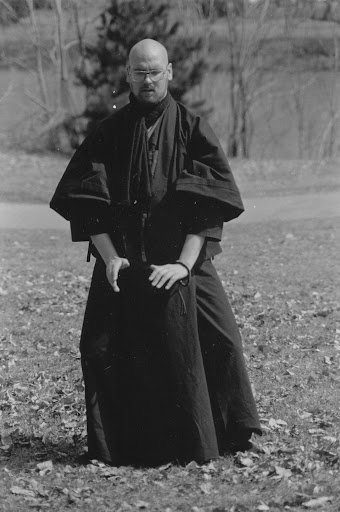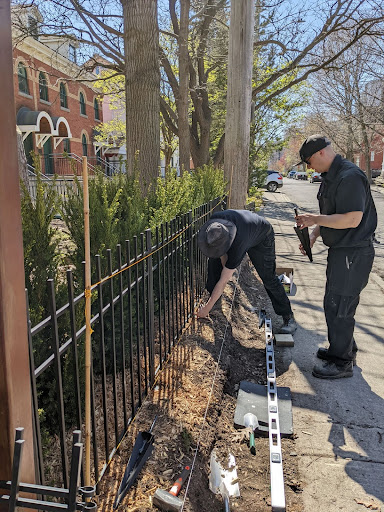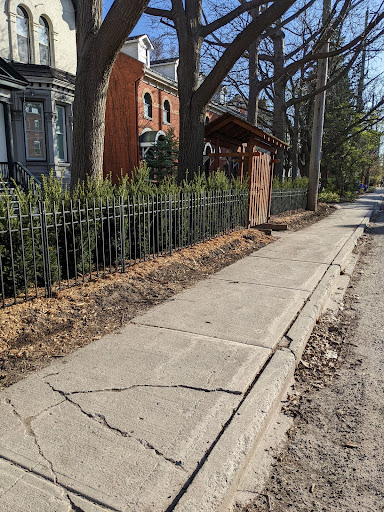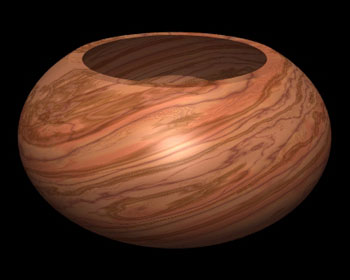
Ven. Anzan Hoshin roshi teaching Daruma-kata-aiki, 1987,
Photograph by the late Ven. Shikai Zuiko o-sensei

Ven. Anzan Hoshin roshi teaching Daruma-kata-aiki, 1987,
Photograph by the late Ven. Shikai Zuiko o-sensei
eMirror Vol 26, No. 21
Friday, May 20th
Edited by the Practice Council
The White Wind Zen Community:
An international community practising and teaching Dogen’s Zen since 1985.
Formal Zen practice has numberless ways of opening to experience. The Zen arts provide a more informal way of continuing this exploration. However, try as I might, I cannot think of a single art form in all of human history that has used feeling and sensations as its context. Isn’t that interesting? This is most likely because the arts have evolved from being crafts to something involving not just the creator of a work, the process of creating the work, and the work itself but the display of the work before an audience. But I suspect that there may be other factors involved.
Feeling is the most intimate of the bodymind’s senses. This is why self-image has traditionally absented itself from the presencing of sensations. Self-image is utterly threatened by bodily sensation. The visual sense can allow a sense of peering out at the world. There can be a sense of scanning surfaces that are all over there, distant from the sense of locatedness as the one doing the seeing. The auditory sense is more pervasive. It is not merely open to what is in front of the face but what is behind the head and underfoot. The bodymind moves in a sea of sounds. But the tactile sense is right here. (SLAP!) When self-image feels impinged upon by colours and forms being cast at it, it blinks the eyes and strengthens the sense of someone behind the eyes pushing back. When it feels pressed upon by sounds it can fire off a sense of irritation at the sounds. So that it does not feel overcome by the vast wealth of sensations, self-image must deaden itself to them or feel backed up not only behind the eyes but back away from the sensations of the head itself.
Sometimes it has no choice. For example, even a trivial pain such as that which might arise in a knee during zazen becomes the subject of a massive assault. In order to try to avoid the pain, the thigh might be tightened and twisted which then torques the hips unnaturally; the shoulders and back muscles are also twisted, the neck is distorted, the head is lopsided. This is part of trying to tie a kind of tourniquet between the sense of locatedness up here behind the eyes and the pain down below. All through this, the sense of being here and the pain being there becomes stronger and stronger. The sense of being somewhere behind the eyes becomes more and more pronounced but the sensations even at the back of the neck, the cheeks, the forehead become entirely or almost entirely absent. I say almost because the tip of the nose might begin to itch at about this point.
Ven Anzan Hoshin roshi, continuing Class Three: "Touching the Sensation of the World" in the series "Zen Arts: The Flowering of the Senses", October 1999 Daruma-ki O-sesshin, Dainen-ji.
Fusatsu: June 1st, 15th and 29th.
Samu Weekend on May 28th and 29th:
We shall be holding a Samu Weekend on Saturday, May 28th and Sunday the 29th. The samu will take place from 9:00a.m. to noon and from 1:30pm. to 6:00p.m. on each day with a meal at noon for those attending for the full day. Spring work will be taking place in the grounds as well as samu inside the building which will include painting the basement stairs and installing a plywood floor in the unfinished areas of the East Wing on the ground floor. We shall be continuing to wear masks during the samu.
Please send an email to saigyo.cross@gmail.com or by leaving a message on the office answering machine at 613 562 1568 if you are able to offer samu over this weekend. Please let us know if you have any dietary restrictions if you are planning on staying for lunch.
June Two-day Sesshin:
The June two-day sesshin will begin at 8:00 p.m. on Friday, June 10th and will end at 6:00 p.m. on Sunday, June 12th.
Hermitage:
The Roshi is currently in an extended period of "self-isolation" due to underlying health issues until the COVID-19 situation clarifies.
Beginning Instruction in Zen Practice:
For information concerning our Long-distance Training Program, please visit this Web Page: https://wwzc.org/long-distance-training-program
Deshi Isshin sat the full week of the Sogaku-ki O-sesshin in her home in Saint John, New Brunswick.
Rev. Chiso anagarika sat her weekly semi-retreat on Tuesday, May 17th at her home in the Berkshires. Aaron Ford sat a half-day retreat on Friday, May 13th at his home in Calgary, Alberta Julien Jefferson sat a half-day retreat on Saturday, May 14th at his home in Nova Scotia.
If you would like to sit a retreat at home please follow the schedule outlined in this page: https://wwzc.org/retreat-schedule-public-students. After your retreat, please send an email to schedule@wwzc.org to confirm that you sat a retreat and include the duration and location.
On Saturday, May 7th, Saigyo ino, Fushin shramon and David installed a new 36” high fence in front of the yews to protect them from the many dogs in the neighbourhood, who like to stop and mark hedges. Dog urine is very acidic, which is detrimental to young yew trees. We also plan to add a wooden border so that the mounded soil around the yews is not washed away by rain. It will also help protect the yews from salt spread on the road and sidewalks during the winter months.
Many of the neighbours walking or driving past the building made complimentary remarks about the hedge and the fence.
Funding for the fence came from a donation by a student, so fundraising for this was not necessary.

Saigyo ino and Fushin shramon working on the fence.

Newly Installed Fence Along Daly Avenue
Saturday, May 21st to Saturday, May 28th
Saturday, May 21st: Bodymind of the Way: Zen Master Anzan Hoshin's Commentaries on Eihei Dogen zenji's "Shinjin Gakudo": "Evening Comments: Practice, Pain, and Posture" (6 of 17)
Sunday, May 22nd: SAkN “Root Cycle Four” by Ven. Anzan Hoshin roshi: “Introduction to Finite and Infinite Motion” (teisho 3 of 5)
Monday, May 23rd: “Every Breath You Take” by Ven. Shikai Zuiko o-sensei: “Seeing Armoured People" (Dharma Talk 90)
Thursday, May 26th: "Simple Minded" by Ven. Jinmyo Renge sensei
Saturday, May 28th: Bodymind of the Way: Zen Master Anzan Hoshin's Commentaries on Eihei Dogen zenji's "Shinjin Gakudo": "Mountains, Rivers, and Earth: the Geography of Bodymind" (7 of 17)
Associate and general students should continue to follow the recorded Teachings schedule for the sitting you were attending at the monastery, and listen to that during your home practice.
You can access the online Recorded Teachings Library at wwzc.org/recorded-teachings-schedule.
You can also use the streaming site at app.wwzc.org to live stream recordings from the online Library. If you have forgotten your password or need assistance with accessing the recorded Teachings, please email schedule@wwzc.org.
Please note that teisho should be listened to in the correct order and with none missed out as themes, metaphors, questions raised and answered evolve in spirals throughout the series.
While most of the online Recorded Teachings library is password-protected and only accessible to students of the Lineage of Zen Master Anzan Hoshin, a small selection of MP3 recordings of teisho are accessible to the public at wwzc.org/recorded-teachings Additional recordings will be uploaded periodically. MP3 recordings of four recorded teisho by Ven. Anzan Hoshin roshi are currently available:
Dharma Position https://wwzc.org/dharma-position
Eyes See, Ears Hear https://wwzc.org/eyes-see-ears-hear
Embarrassment https://wwzc.org/embarrassment
Ven. Anzan Hoshin roshi's reading of his translation of Eihei Dogen zenji's “Bendowa: A Talk on Exerting the Way”: https://wwzc.org/bendowa-talk-exerting-way

Photograph of Ven. Anzan Hoshin roshi at Daijozan, mid-1980s,
by Ven. Shikai Zuiko sensei
Ven. Anzan Hoshin roshi has recently completed translation work on some shorter texts by Eihei Dogen zenji from the Shobogenzo. The work on these particular texts is based upon the literal translations that he worked on with Joshu Dainen roshi at Hakukaze-ji around 1977-78 followed by many years of putting them down, picking them up, and polishing. Naturally, more essential texts such as Uji, Genjokoan, Shinjin Gakudo and some 40 others were completed first and have been given extensive commentaries by the Roshi. This batch of texts includes Baike: Plum Blossoms, Ryugin: Howling Dragon, and Udonge: The Udumbara Blossoming and many others are nearing completion. Annotation details and successfully conveying them across various document formats are the issue at this point.
Work on Bussho: Buddha Nature, a very long and nuanced text by Dogen zenji, is ongoing.
Roshi is also finishing an update to the Saijo Shingi: The Deportment of Radiance, our manual of monastic training standards which is a supplement to the ancient Eihei Shingi and Keizan Shingi.
Begun by Ven. Shikai Zuiko o-sensei
Finished by Rev. Fushin Comeau shramon following her death

Tanden (J) Area of the belly three finger widths below the navel. See also "hara".
Posted May 13th , 2022. New entries are posted every two weeks.

Dogen zenji taught in the Tenzo kyokun: Instructions for the Tenzo (https://wwzc.org/dharma-text/tenzo-kyokun-instructions-tenzo) that the work of preparing and serving meals is "a matter for realized monks who have the mind of the Way or by senior disciples who have roused the Way-seeking mind." In alignment with this, part of Zen Master Anzan Hoshin's samu for the Community involves personally overseeing the activities of the ancient office of tenzo. Ven. Jinmyo Renge sensei serves as tenzo and Mishin godo and Saigyo ino offer assistance as tenzo-anja. The following meals were prepared for residents on Monday, Tuesday and Thursday evenings.
The following meals were prepared during the week of O-sesshin:
Saturday:
Breakfast: Fresh wonton noodles, strips of Spanish onion, red bell, poblano, and cubanelle peppers, ginger, garlic, shoyu, roasted chile paste, oyster sauce; scrambled eggs.
Lunch: Mixed grain (white and brown Calrose and arborio rice; miso shiru (broth made from kombu, slivered ginger, shiro miso, fresh shiitake mushrooms, Shanghai bok choy, shoyu, mirin, rice vinegar); takuan and gari.
Supper: Everything served at room temperature due to the heat of the day. Biryani (basmati rice, cubed potatoes, Spanish onion, carrots, lentils, currants, rice bran oil, butter, curry powder, turmeric, coriander powder, garam masala, salt, pepper); mango soup (chopped white onion, thinly sliced potato, mango juice, turmeric, cayenne, salt, pepper); salad of chopped tomatoes, cucumber, and monastery-grown speckled pea sprouts dressed with cottage cheese pureed until smooth with lemon juice, salt, black pepper, then mixed with minced lime pickle.
Sunday:
Breakfast: Leftover biryani, scrambled eggs.
Lunch: Thai jasmine rice garnished with sauteed daikon in chile sauce ; spicy wakame seaweed soup (leftover strained miso shiru broth and shiitake mushrooms, wakame, ginger, shoyu, roasted chile oil), with silken tofu; kimchi.
Supper: Coconut rice (Thai jasmine rice cooked with coconut milk) garnished with roasted peanuts; dai gai choy and tofu in satay sauce (chopped white onion, red bell peppers, dai gai choy, sliced tofu, peanut butter, chile garlic sauce, coriander powder); chopped Asian pear dressed with lime juice and chile flakes.
Monday:
Breakfast: Fried rice (leftover coconut rice, Spanish onions, red bell peppers, scallions); scrambled eggs.
Lunch: Calrose rice; miso shiru (broth made from kombu, slivered ginger, shiro miso, fresh shiitake mushrooms, Shanghai bok choy, shoyu, mirin, rice vinegar); takuan and gari.
Supper: Conchiglie in garlic butter sauce (chopped Spanish onion, lots of minced garlic, chile flakes, white wine, salt, black pepper, cream); greens and red kidney beans (sliced gailan and Napa seared on the griddle with sliced red onion, red kidney beans, black pepper, balsamic vinegar); friulano and gherkins.
Tuesday:
Breakfast: Leftover pasta; scrambled eggs.
Lunch: Thai jasmine rice with sauteed daikon in sweet chile sauce; spicy wakame seaweed soup (leftover strained miso shiru broth and shiitake mushrooms, wakame, ginger, shoyu, roasted chile oil), with silken tofu; asian pear with lime juice and chile flakes.
Supper: Basmati rice; black lentil dal made by Jinmyo sensei; salad of chopped cucumber, celery, Asian pear, and raita (seeded, sliced cucumber, grated cucumber, plain yogurt, salt, black pepper, ground coriander).
Wednesday:
Breakfast: Cabbage congee (calrose rice, slivered ginger, sesame oil, shoyu, salt, white pepper, seared sliced green cabbage); scrambled eggs.
Lunch: Calrose rice; miso shiru (broth made from kombu, slivered ginger, shiro miso, fresh shiitake mushrooms, Shanghai bok choy, shoyu, mirin, rice vinegar); takuan and gari.
Supper: Roasted Yukon gold potatoes (large cubes of Yukon gold potatoes parboiled then tossed with rice bran oil, salt, and pepper and roasted) garnished with fresh parsley; chile tofu (sliced medium-firm tofu sauteed in butter then braised in a mix of Yeo’s sweet and Yeo’s hot chile sauce); salad of leaf lettuce, romaine, radishes, celery, tomatoes, with dressing (mayonnaise, dijon mustard, apple cider vinegar, small amount of honey).
Thursday:
Breakfast: “Rice and eggs” (calrose rice sprinkled with Memmi sauce and topped with very gently over easy eggs garnished with Memmi and togarashi pepper).
Lunch: Mixed leftover rice; spicy wakame seaweed soup (leftover strained miso shiru broth and shiitake mushrooms, wakame, ginger, shoyu, roasted chile oil), with silken tofu; pickled daikon (cubes of daikon quick-pickled in apple cider and white vinegar, water, sugar, salt).
Supper: White and brown jasmine rice garnished with toasted coconut flakes; tamarind curry, sliced deep fried tofu, chopped Spanish onion, chopped poblano and red bell peppers, Napa cabbage, lime juice); sliced fresh pineapple and Asian pear with lime juice, red chile flakes, salt and white pepper.
Friday:
Breakfast: Fried leftover jasmine rice mixed with tofu.

If you would like to thank someone for a contribution they have made, please feel free to send an email to Jinmyo sensei at rengezo@gmail dot com, but be sure to type "eMirror” in the subject line.
From Fushin shamon:
Thank you to the Roshi for this Sogaku-ki O-Sesshin. Thank you to Jinmyo sensei for leading the sittings throughout this training period and for tireless encouragement. Thank you to Mishin godo for excellent meals three times daily for the past week. They always hit and are always an interesting variety of flavours and textures. Thank you to Saigyo ino for the mountain of work put forward to complete the Shuryo on the first floor of Dainen-ji. It is a very beautiful room.
|